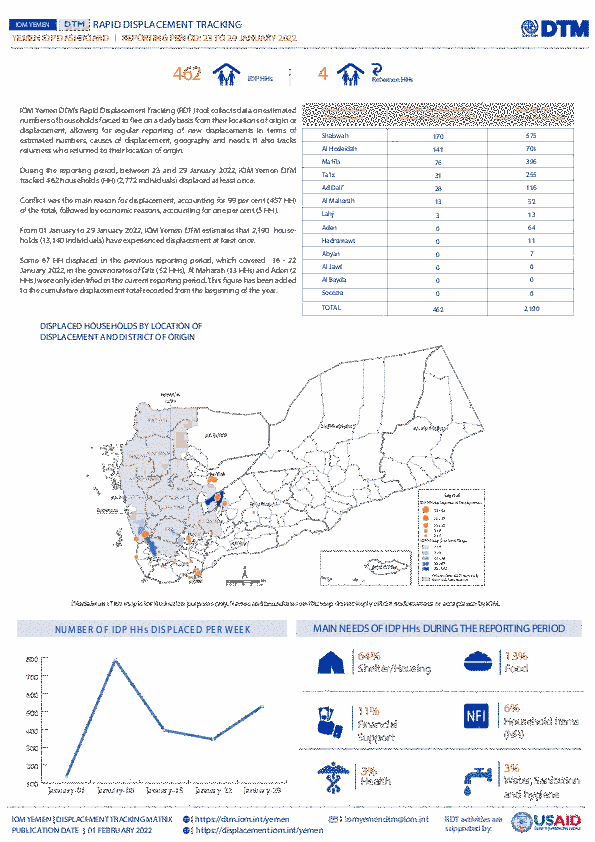-
Countries
-
Data and Analysis
-
Special Focus
-
Crisis Responses
Yemen — Rapid Displacement Tracking Update (23 - 29 January 2022)

Contacter
DTM Yemen, iomyemendtm@iom.int
Langue
English
Emplacement
Yemen
Période couverte
Jan 23 2022
Jan 29 2022
Activité
- Rapid Emergency Registration
- Mobility Tracking
IOM Yemen DTM’s Rapid Displacement Tracking (RDT) tool collects data on estimated numbers of households forced to flee on a daily basis from their locations of origin or displacement, allowing for regular reporting of new displacements in terms of estimated numbers, geography, and needs. It also tracks Returnees who returned to their location of origin.
From 01 January 2022 to 29 January 2022, IOM Yemen DTM estimates that 2,190 households (HH) (13,140 Individuals) have experienced displacement at least once.
Since the beginning of 2022, DTM also identified 4 displaced households who left their locations of displacement and either moved back to their place of origin or another location.
Between 23 and 29 January 2022, IOM Yemen DTM tracked 462 households (2,772 individuals) displaced at least once. The top three governorates and districts where people moved into/within are:
- Shabwah (170 HH) – Ataq (122 HH), Bayhan (30 HH), Ayn (18 HH) districts. Most displacements in the governorate were internal.
- Al Hodeidah (141 HH) – Hays (114 HH), Al Khukhah (27 HH) districts. Most displacements in the governorate originated from Al Hodeidah and Taiz.
- Marib (76 HH) – Marib City (49 HH), Marib (27 HH) districts. Most displacements in the governorate originated from Marib and Shabwah.
Most displacements resulted from the increased conflict in the following governorates and districts.
- Shabwah (159 HH) – Ayn (159 HH) district.
- Al Hodeidah (99 HH) – Hays (85 HH), Al Hawak (4 HH), Al Khukhah (3 HH) districts.
- Taiz (93 HH) – Maqbanah (61 HH), Jabal Habashi (18 HH), Sabir Al Mawadim (4 HH) districts.
